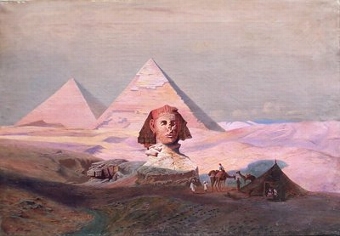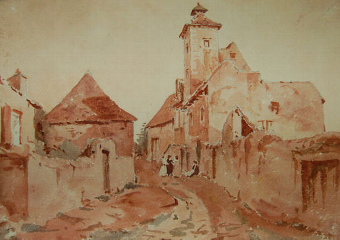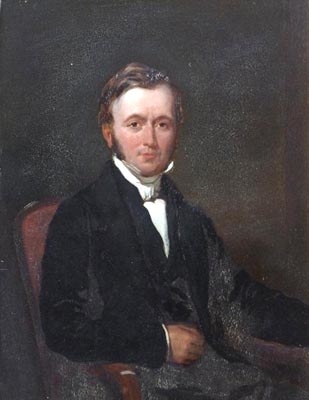the palace of westminster from the thames and westminster abbey beyond
- View other items in:
- antiques interior design modern and vintage
- other interior design
artware ltd
Enquire about this antique
Artware Ltd has 565 antiques for sale.
click here to see them all
The Palace of Westminster, also known as the Houses of Parliament or Westminster Palace, is the seat of the two houses of the Parliament of the United Kingdom?the House of Lords and the House of Commons. It lies on the north bank of the River Thames[note 1] in the heart of the London borough of the City of Westminster, close to the historic Westminster Abbey and the government buildings of Whitehall and Downing Street. The name may refer to either of two structures: the Old Palace, a medieval building complex most of which was destroyed in 1834, and its replacement New Palace that stands today; it has retained the style and status of a royal residence, despite its actual use. The first royal palace was built on the site in the eleventh century, and Westminster was the primary London residence of the Kings of England until a fire destroyed much of the complex in 1512. After that, it served as the home of Parliament, which had been meeting there since the thirteenth century, and the seat of the Royal Courts of Justice, based in and around Westminster Hall. In 1834, an even greater fire ravaged the heavily rebuilt Houses of Parliament, and the only structures of significance to survive were Westminster Hall, the Cloisters and Chapter House of St Stephen''s, the Chapel of St Mary Undercroft and the Jewel Tower. The subsequent competition for the reconstruction of the Palace was won by architect Charles Barry and his design for a building in the Perpendicular Gothic style. The remains of the Old Palace (with the exception of the detached Jewel Tower) were incorporated in its much larger replacement, which contains over 1,100 rooms organised symmetrically around two series of courtyards. Part of the New Palace''s area of 3.24 hectares (8 acres) was reclaimed from the Thames, which is the setting of its principal fa?ade, the 265.8-metre (872 ft) river front. Barry was assisted by Augustus W. N. Pugin, a leading authority on Gothic architecture and style, who provided designs for the decoration and furnishings of the Palace. Construction started in 1840 and lasted for thirty years, suffering great delays and cost overruns, as well as the death of both leading architects; works for the interior decoration continued intermittently well into the twentieth century. Major conservation work has been carried out since, due to the effects of London''s pollution, and extensive repairs took place after the Second World War, including the reconstruction of the Commons Chamber following its bombing in 1941. The Palace is one of the centres of political life in the United Kingdom; "Westminster" has become a metonym for the UK Parliament, and the Westminster system of government has taken its name after it. Its Clock Tower, in particular, which has become known as "Big Ben" after its main bell, is an iconic landmark of London and the United Kingdom in general, one of the most popular tourist attractions in the city and an emblem of parliamentary democracy. The Palace of Westminster has been a Grade I listed building since 1970 and part of a UNESCO World Heritage Site since 1987.
The official designation is the Palace of Westminster, from the Palace built by Edward the Confessor. It was used as a royal palace by successive Sovereigns until Tudor days. Edward III built St Steven''s Chapel, where the Commons sat from 1547 until 1834, hence the frequent reference to the Commons as St Stephen''s. It is said that the custom of members bowing to the Speaker''s chair is due to standing before the altar in the chapel. In 1834 a fire destroyed the whole of the palace with the exception of St Stephen''s Chapel, the Great Hall (Westminster Hall) and the ?Jewel Tower?. Sir Charles Barry was commissioned to rebuild. His fine building, covering 8 acres, is the largest modern Gothic style edifice in the world. The foundation stone was laid in 1840. Seven years later the Lords met for the first time in the new chambers and in 1852 the building was completed. Frequent and almost continual repair work is necessary owing to the nature of the stone, magnesium limestone from Yorkshire, used in its construction. The face of the building is elaborately decorated; there are over 300 statues of kings, queens, saints and worthies. The Clock Tower is 320 ft high and displays the great clock whose dials are 23 ft in diameter, the minute spaces are 1 ft apart, the figures 2 ft long, the copper minute hand 14 ft long and the hour hand 9 ft. "Big Ben" is not the clock but the great bell (13? tons) named after Sir Benjamin Hall, the First Commissioner of Works, when it was hung. Long familiar to London, the broadcasting of its sonorous note has made it a well-known sound all over the world.
When the house is sitting this is indicated by day by a flag flying above the Victoria Tower and at night by a light in the Clock Tower. Owing to the danger of subsidence the tower was built very slowly, 30 ft. a year, and was not completed until 1857. It soars to the height of 340 ft, that is, 20 ft. higher than the Clock Tower. The public entrance to the Houses of Parliament is by a doorway in the Victoria Tower. The Royal Staircase leads to the Norman Porch, from which a door opens into the Queens Robing room. Here the Queen dons her robes of State before proceeding to the House of Lords for the State Opening of Parliament. The chamber is adorned with panels and frescoes illustrating the story of King Arthur. It was used by the Lords when they vacated their Chamber in favour of the Commons after the House of Commons had been bombed. Next is the Royal Gallery. Here is the memorial to members of the House and their sons who fell in the First World War, unveiled in 1932 by the Duke of Windsor, then Prince of Wales. Two huge paintings on the walls, by Maclise, are "The Death of Nelson", and the "Meeting of Wellington and Blucher." It is a sumptuous hall, 110 ft long, with a magnificent gilded ceiling and a fine mosaic floor. The next room, the Princes Chamber, contains a statue group of Queen Victoria and bas-reliefs representing the events of the Tudor period and portraits of the Tudor Sovereigns. The House of Lords is the finest apartment in the palace. At the south end are the Royal Thrones and the Woolsack, the seat of the Lord Chancellor. Beyond is the Peers'' Lobby and the Peers'' Corridor, with frescoes of Stuart history; it leads to the Central Hall, with more frescoes of the Tudor period. Beyond is the House of Commons. On the 10th of May 1941, it was practically destroyed by incendiary bombs. The new Chamber, rebuilt in its original form, was opened by King George VI in October 1950. Entrance is by the Churchill Arch, built of stone scarred by the fire of 1941. Here, the Churchill Statue, unveiled in 1969, stands opposite the statue of Lloyd George. St Stephens Hall, which occupies the site of the old chapel is where the Commons sat from 1547 to 1834. Brass studs in the floor indicate the position of the Speaker''s Chair. Over a century later the members of the Commons again made use of it, for the State Opening of Parliament until their Chamber was rebuilt.
Antiques.co.uk Ref: CXUH4Q2X
- Materials:
- Oil on Canvas
- Width (cm):
- 50.80 x 76.20 cm 20 x 30 ins
Artware Ltd
Artware Fine Art specialises in fine antique, decorative and historical portraits and topographical pictures . We cover a period from the 17th and 18th centuries through to the 19th & 20th Centuries. We have over 150 portraits in stock, which can be viewed on our web site, each historical portrait has well researched biographical information both on the sitter and the artist.
Contact details
18 La gare
51 Surrey row
London
Greater London
SE1 0BZ
UNITED KINGDOM
T: 0207 921 97904
E: greg@artwarefineart.com
W: www.artwarefineart.com














